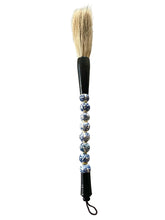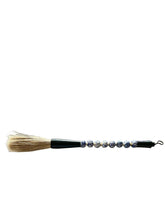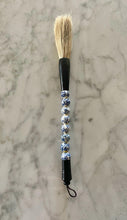Vintage Calligraphy Brush, Blue and White Porcelain Chinoiserie Floral Design Beads
Regular price
$20.00
Sale
Handmade Vintage Chinese Calligraphy Brush with beautiful Blue and White Chinoiserie Floral Design Porcelain Beads combine with delicate horsetail hair brush head, to create this unique brush in a modern interpretation of historic calligraphy brushes to create a beautiful collectible objet.
DIMENSIONS: 10.5" L x .5" W x .5" Dia
MATERIALS: Blue and White Porcelain Beads, Rosin Ferrule, Horse Tail Hair Brush
ORIGIN: Jingdezhen, China
*Please note these are one of a kind, handmade objects they may contain imperfections or irregularities associated with artisan crafted items. These are not defects but desirable characteristics of the item.
FACTS & HISTORY: In China calligraphy is a fine art which surpasses painting, sculpture, ceramics, poetry and influences every aspect of Chinese life. A person’s handwriting skills reveal proper education, self-discipline and generally someone's personality. Chinese calligraphy represents and reveals someone's character and mentality, therefore, excellent handwriting gives satisfaction and respect. Calligraphy is performed by people of all ages and backgrounds. In contemporary China, calligraphy is more than a hobby. It is a way of life!
For calligraphy, the brush has the most important role, and its techniques are known as brushwork. The most important about brush is its flexibility. The tuft is made of hair from different animals as hair for brushes. Depends on which animal hair is used, the season and from which animal part is taken, creates varying degrees of firmness and softness, as the quality of the brush.
Chinese characters are an important part of ancestral worship tablets and fortuneteller’s cards, and are more than decoration on doors for good luck, but a tool to send away evil spirits. During festivals, brush-written couplets are on public display. Most of the couplets contain characters such as: good fortune/blessings (chin. 福 fú) and, longevity (Chin. 壽 shòu). Before China witnessed the usage of hard pens and pencils, the brush was the only writing tool. Brush writing was a skill every educated man had to master. Since the seventh century, in China was introduced the imperial civil service examinations. It had the role to determine most suited one’s to enter the government’s bureaucracy. Calligraphy was an important testing subject, and a tool for how to test knowledge in other subject areas. The testing system granted people with talent and abilities to have progressed in society.
As calligraphy became a very important subject, and matter of talent, from a very early age, students would start learning calligraphy and Confucianism. At the beginning of 20th century, the civil service examinations were abolished, but still in China good handwriting is extremely valued.
Traditionally in China, learning skills, handwriting mastery, and an official post were hand to hand combination. Most of China’s rulers were masters of calligraphy, with outstanding talents and calligraphy creations. For instance, Song dynasty Emperor Huizong (1082–1135) created his own style called “Slender Gold”.








